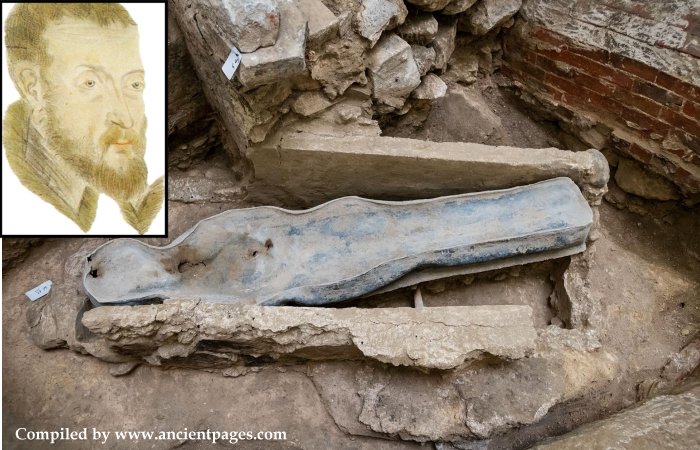Jan Bartek - AncientPages.com - Two years ago, scientists made a significant discovery at Paris’ Notre Dame Cathedral: an ancient sarcophagus. This finding was immediately recognized for its substantial historical value.
According to the French Ministry of Culture, during the preparatory work to rebuild the temple spire, several tombs and a "completely preserved" lead sarcophagus were uncovered in the shape of a human figure. The individual's identity interred in this lead coffin remains unknown; however, researchers speculate that it may have been intended for a "senior dignitary" and likely dates back to the 13th century—approximately one century after the cathedral's construction.
Notre Dame's mysterious sarcophagus. Credit: Denis Gliksman/Inrap
One month following this discovery, it was officially announced that the enigmatic lead coffin would be opened to unveil its secrets. Forensic experts and scientists will examine the sarcophagus and analyze its contents to determine the skeleton's gender and former state of health. Lead archaeologist Christophe Besnier indicated that carbon dating technology might be employed in this investigative process.
According to a recent study, INRAP has informed us that nearly all individuals unearthed inside Notre-Dame are adults. Most exhibit pathologies associated with aging, such as osteoarthritis, tooth loss, or cartilage ossification, indicating an elderly population. With one exception, all skeletons are male.
All exhumed skeletons undergo an exhaustive anthropological study. Additionally, radiocarbon dating, paleogenomic analyses, and isotopic analyses will be conducted to reconstruct the geographical origin and mobility of the individuals.
The Unknown Man In The Lead Coffin Was A Horse Rider and Poet
INRAP reports that forensic experts at the University Hospital of Toulouse have examined the man in the mysterious lead coffin. Analysis of his femurs led scientists to conclude that he was an avid rider, earning him the nickname "the rider" in professional circles. Further examination revealed that he suffered from tuberculosis, which resulted in chronic meningitis.
Experts have studied the remains. Credit: Denis Gliksman/Inrap
The research team lead by Professor of biological anthropology Éric Crubézy of France's National Center for Archaeological Research explained that this anonymous individual died of chronic tuberculous meningitis in the 16th century during his fourth decade—an age not commonly represented among significant burials within the cathedral. This unknown person is particularly intriguing because he rests in an area where no other intact tombs have been discovered apart from Antoine de La Porte's. Research suggests he may have reoccupied a tomb previously hosting two notable individuals without exceptional religious titles.
Attention was drawn to Joachim du Bellay, a distinguished horseman and poet who succumbed to tuberculosis-induced chronic meningitis in 1560. Despite being buried within Notre Dame when no longer serving as canon, his tomb was not located near his uncle’s as desired by his family during searches conducted in 1758. This discrepancy highlighted conflicts between burial choices made by Notre Dame's chapter and locations within the transept’s cross.
Statue of Joachim du Bellay. Credit: Emmanuelc - CC BY-SA 3.0
Two hypotheses have been proposed: either du Bellay's temporary burial became permanent, or his coffin was transferred during another burial event in 1569 following the publication of his complete works.
The Renaissance poet Joachim du Bellay, who lived from 1522 to 1560, appears to align with the forensic evidence. "He traveled from Paris to Rome, a considerable achievement given his tuberculosis. In fact, he nearly succumbed to the illness," Crubézy stated during a press conference.
See also: More Archaeology News
However, this thesis is not universally accepted. Christophe Besnier, one of the individuals responsible for the excavations at Notre Dame, highlights that an isotope analysis indicates that the individual in the sarcophagus resided around Paris or in the Rhône-Alpes region of southeastern France until approximately age ten. This finding contradicts Bellay's known origins in western France.
Thus, whether or not the enigma of Notre Dame’s sarcophagus has been resolved remains an open question subject to further scholarly debate.
Written by Jan Bartek - AncientPages.com Staff Writer
Expand for references







